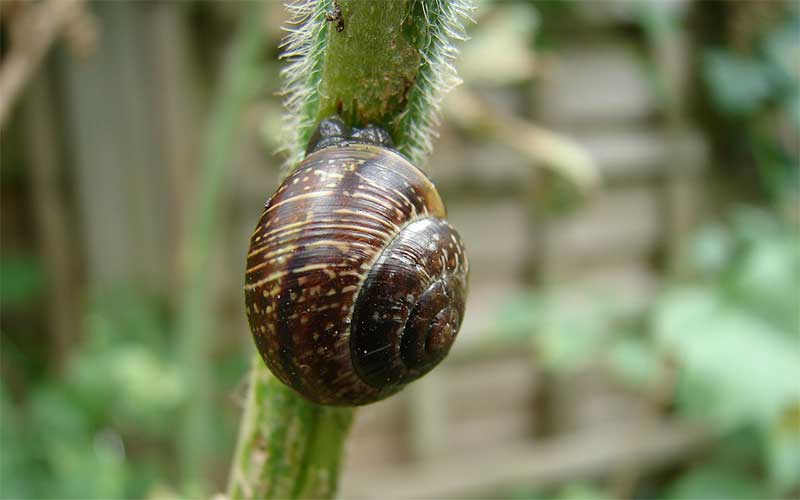Snails feed on a variety of food found in their natural habitat. What they consume depends on where they live and the species of snail that they are. Some conventional foods are plants, fruits, vegetables, and algae. Plants that are dying are often a good meal for them, and they also eat sand or soil when seeking for calcium to get a thicker shell.
Snail diet
Most terrestrial snails are herbivorous, but others are omnivorous and some even carnivorous. Each species has different eating habits, depending on their size, age, habitat and individual nutritional requirements. You will likely find snails around your garden as this offers them plenty of fresh plants and leaves to eat.
The herbivorous snails devour a wide variety of live plant parts: leaves, stems, plant crops, bark, and fruits. Many consume fungi and mushrooms, and others may occasionally add algae, although these are an important food for freshwater snails.
Some snail species enjoy plants that are already dead, as well as animals or any dead organic matter. These individuals are detritivores because they feed on debris or solid residues that remain in the soil.
Carnivorous snails eat several types of small animals; this is the case of the species of the genus Powelliphanta, which live in New Zealand and feed on other gastropod mollusks such as slugs and earthworms, among other terrestrial animals.
On the other hand, omnivores can include plants and animals into their diet, but usually, these animals prefer other terrestrial animals, so they are practically predators. For example, the species Rumina decollata can eat other species of conch, slugs, annelids like worms and, to a lesser extent, plants.
Snails have to feed on foods that include significant amounts of calcium to keep their shell hard. When looking for food they use their powerful sense of smell.
They are nocturnal so that they look for food during the night or the very early morning hours. (2) They consume more food than usual if the winter approaches so they can store up fat reserves to live on while they hibernate.
When food sources are very low in the summer or spring months, they may voluntarily put their body into a state of estivation as well. This process allows them to survive in severe conditions of drought. (3)
A singular mouth
The mouth of terrestrial snails is unknown to most people. Have you ever wondered how they eat? These mollusks have an organ in the mouth with rows of tiny teeth, sometimes compared with a tongue, fully functional at the time of eating.
The radula is this structure inside the snail’s mouth that has rows of chitin teeth. When the food reaches this structure that looks like a sac, the teeth do not cut or grind it like human teeth would. Instead of being chewed, the radula scrapes the food and breaks it, before it passes through the esophagus to continue the digestion process.
These tiny teeth suffer much wear and tear as time passes. Therefore, they are continually replaced by others. Not all species have the same number of teeth. Some have rows with a few, but in others the number reaches hundreds.
Snails are often said to be very noisy eaters. However, the sounds you hear aren’t them consuming the food. It is the radula tearing and scraping the food.
A problematic diet?
A Massive number of snails in a garden or even worse in farms with crops can quickly become a serious problem. They will consume enough to ruin the harvest.
Certain terrestrial species, such as the Giant African Snail (Achatina fulica), are a headache for farmers and owners of crops since they have no scruples about consuming economically valuable plant species such as cacao, cucumber, papaya, Bean, squash, cauliflower and some cereals, just to name a few. This species, considered in many countries an invasive animal, generates important economic losses.
Snails as pests
You may have never seen a terrestrial snail eat, but its appetite is huge. In fact, in many places, these eating habits mean a real problem for humans.
If you use herbicides or pesticides on your plants, you may be causing the death of many snails without even realizing it.
Some with gardens or farms strive to trap the snails rather than killing them. They either release them back into a new environment, or they sell them. One of the easiest ways to catch them is to place lids of jars with some beer in the garden.
Large farms with large land extensions have another way to deter snails from eating their crops. They put 6-inch screens of copper on the ground. The slime from the snails doesn’t seem to mix very well with the copper, and that means they will stay away from the crops. This method has been very successful.
In spite of the above, other snails have been used in turn as pest controllers, since they eat harmful parasites to some plants.
Sources:
(1) http://www.pbs.org/kcet/shapeoflife/resources/snail.html
(2) http://pss.uvm.edu/ppp/pubs/el14.htm
(3) http://www.ipm.ucdavis.edu/PMG/PESTNOTES/pn7427.html
BioExpedition Publishing © 2017.




